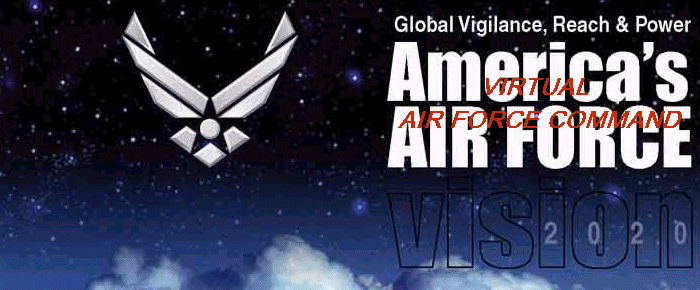
|
|
|
|
Flying TrainingNineteenth Air Force, with headquarters at Randolph AFB, Texas, conducts AETC's flying training. Items highlighted with bold
black text designate locations and aircraft used by VAFC in
the particular training tracks. Air Force pilot candidates begin with introductory flight training (IFT). In IFT,
civilian instructors provide 50 hours of flight instruction to pilot candidates who must
complete requirements for a private pilot license. Pilot candidates then attend either Euro-NATO joint jet pilot training (ENJJPT) or
joint specialized undergraduate pilot training (JSUPT). ENJJPT is located at Sheppard AFB, Texas. The entire course lasts about 54 weeks.
Students learn with, and are taught by, U.S. Air Force officers and officers from various
air forces of our European allies. Student pilots first fly the T-37 mastering contact,
instrument, low-level and formation flying. Next, they strap on the supersonic T-38 and
continue building the skills necessary to become a fighter pilot. JSUPT students accomplish primary training in the T-6 Texan II at one
of three Air Force bases – Columbus AFB, Miss., Laughlin AFB, Texas, or Vance
AFB, Okla; or in the T-34C Turbomentor at Naval Air Station Whiting Field, Fla.
Joint training is conducted at Vance AFB, Okla., and NAS Whiting Field for students from
the Air Force and Navy. During the primary phase of JSUPT, students learn basic flight skills common to all
military pilots. Students will soon use the Joint Primary Aircraft Training System during the primary
training phase. The aircraft portion of JPATS is the T-6 Texan II, which
is being phased in as the primary trainer replacing the Air Force's T-37 and the Navy's
T-34C. After the primary phase of JSUPT, student pilots elect one of several advanced training
tracks based on their class standing. Prospective airlift and tanker pilots are assigned to the airlift/tanker track and
train in the T-1 Jayhawk at Columbus AFB, Miss., Laughlin AFB, Texas, or Vance
AFB, Okla. Student pilots headed for bomber or fighter assignments are assigned
to the bomber/fighter track and train in the T-38 Talon at Columbus, Laughlin or Vance.
Students assigned to the multi-engine turboprop track fly the T-44 turboprop
trainers at NAS Corpus Christi, Texas, and will eventually fly the C-130
Hercules. Those students selected to fly helicopters are assigned to the helicopter track and fly
the UH-1 Huey at Fort Rucker, Ala. Nineteenth Air Force also provides follow-on training for most Air Force pilots in
their assigned aircraft. Pilots assigned to fighter aircraft complete the introduction to
fighter fundamentals course at Randolph AFB or Sheppard AFB, Texas, or Moody AFB, Ga.,
flying the AT-38B, and then move on to train in either the F-15 Eagle at Tyndall AFB,
Fla., or the F-16 Fighting Falcon at Luke AFB, Ariz. Altus AFB, Okla.,
hosts training for pilots assigned to C-5 Galaxy, C-141 Starlifter, KC-135
Stratotanker or C-17 Globemaster III aircraft. Aircrews assigned to fly the C-130
train at Little Rock AFB, Ark., and pilots assigned to fly MC-130 Combat
Talon, HC-130 aircraft, UH-1N, MH-53 Pave Low or HH-60 Pave Hawk helicopters
receive their training at Kirtland AFB, N.M. Keesler AFB, Miss., provides
training for pilots assigned to the C-21, and the Army at Fort Rucker, Ala., provides
training in the C-12 Super King Air. In addition to pilot training, Nineteenth Air Force provides joint specialized
undergraduate navigator training. JSUNT is conducted at Randolph AFB and NAS Pensacola,
Fla., and provides training for Air Force, Navy and Marine student navigators. Students at
Randolph complete training in the T-43A and move to follow-on assignments in transport and
tanker aircraft such as the C-130 and KC-135. Students at NAS Pensacola, Fla., complete primary and intermediate training in the
T-34C and T-1 aircraft, and then enter the one of two tracks in the next phase. Students
in the strike track will serve as navigators in the B-52 Stratofortress or as weapon
systems officers in the B-1B Lancer. Navigators assigned to the B-1B attend a special
training program at Randolph. Students in the strike/fighter track will receive follow-on
assignments in the F-15E Strike Eagle as weapon systems officers and attend special
training in the IFF course. AETC also provides enlisted aircrew training for a wide variety of aircrew specialties including flight engineers, air-to-air refueling boom operators, loadmasters, aerial gunners, airborne communications specialists and weapons directors. Flight engineers and boom operators train at Altus AFB, Okla., loadmasters train at Sheppard AFB, Texas, helicopter flight engineers and aerial gunners train at Kirtland AFB, N.M., airborne communications specialists train at Keesler AFB, Miss., and weapons directors train at Tyndall AFB, Fla. |
|
Send mail to VAFC Webmater
with questions or comments about this web site.
|